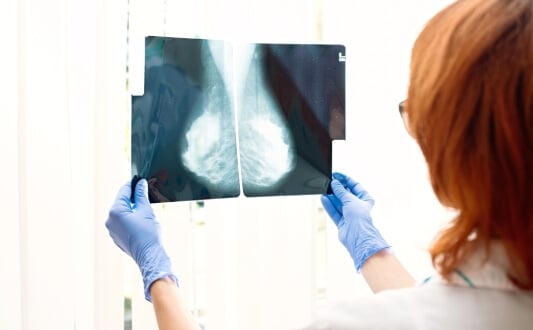If you need information about innovative treatments for stage 4 breast cancer in Germany, you can find it
Breast cancer is one of the most common malignant cancers in women. Occasionally this pathology also occurs in men. The breast cancer code according to ICD-10 is C50. Let's discuss the types of breast cancer and where the tumor can metastasize.
Content
- Classification
- Stages
- Breast cancer and metastases
- Molecular taxonomy
- Hospitals and treatment costs
- Organization of treatment
Classification
Both malignant and benign tumors can form in the mammary gland. Breast cancer is a malignant tumor. It is characterized by infiltrative growth and it produces metastases.
The most important are the following classifications:
- Localization - where the tumor is located
- According to histological structure -what tissues become malignant
- According to TNM - determines the stage, based on the size of the tumor and the presence of metastases
- Molecular taxonomy is used to determine the prognosis of the disease
Malignant breast cancer can develop in various areas of the breast.
Based on the location of the primary tumor, cancer can develop in the following places:
- Nipple
- Areoles
- Axillary part of the breast
- Upper-inner, upper-outer, lower-inner, or lower-outer quadrant
- Unspecified localization
- Outside the specified areas
The primary location of the tumor is important in terms of the prognosis. After all, the lymph and blood go to different vessels from different parts of the chest. Therefore, the location of the tumor determines the pathway of the metastasis. There are various histotypes of breast cancer: colloid carcinoma, metaplastic, lattice, lobular, medullary, papillary, cystic types. There is also an apocrine, cribose, secretory cancer.
According to the rate of how quickly the tumor grows, the following rates are distinguished:
- High - the tumor mass doubles over a period of time in less than 3 months
- Average - doubling occurs in 3-12 months
- Low - the tumor doubles in more than 1 calendar year
According to the form of the tumor, breast cancer can be:
- Nodular - is a clearly limited tumor
- Diffuse - without clear boundaries
- Atypical (this includes Paget's cancer and primary metastatic cancer)
Stages
Staging of breast cancer is based on the classification of TNM, where T is the primary tumor, N is the nearest metastasis, and M is the distant metastasis.
- Stage 0. This is localized cancer. This includes ductal and lobular carcinoma. Paget's disease (nipple) is considered to be cancer on site, if there are no signs of a tumor.
- Stage 1. There are no regional and distant metastases.
- Stage 2. There is micro-invasion, or a tumour of small diameter - a maximum of 5 cm in the largest dimension. There are metastases in the nearest lymph nodes. These can be axillary or intrathoracic lymph nodes.
- Stage 3. If a tumor is 6 cm or more, there are regional metastases, but there are no distant metastases, this is the third stage of the disease. The neoplasm can spread to the skin and chest wall. Edema, ulceration, a symptom of "lemon peel” are often observed.
- Stage 4. This breast cancer with metastases in the stomach, lungs, bones and other distant organs. The separate article is devoted to methods of bone metastases treatment.
The type of breast cancer is also taken into account. This includes not only the size of the tumor, but also the location, the features of growth, the presence of an inflammatory process.
There are:
- Microinvasion cancer - cells spread to the basal membrane, but the tumor spreads no more than 2 mm
- Multicentric cancer - the presence of multiple synchronously growing tumors in one breast
- Bilateral cancer - tumors occur in both mammary glands
- Inflammatory breast cancer or edematous-infiltrative form of malignant neoplasm. It is accompanied by condensation and redness of the skin, swelling, the presence of cancerous emboli on the skin, which are determined by biopsy
- Paget's cancer is characterized by a lesion in the nipple, obvious signs of a tumor may be absent
Breast cancer and metastases
Breast cancer with metastases is more difficult to treat. The worst prognosis is the presence of distant metastasis.
The tumor spreads in such ways:
- Lymphogenous (through lymphatic vessels)
- Hematogenous (through the blood)
First, there are metastases in the regional lymph nodes:
- Subscapular
- Sub- and supraclavicular
- Parasternal (near the sternum)
- Axillary
Later, metastases appear in the distant lymph nodes. These include collateral axillary and supraclavicular lymph nodes. Through both the lymphogenous and hematogenous way, the tumor metastasizes into the skin, soft tissues, and internal organs. Many women have metastases of breast cancer in the bones.
Here are the main organs where breast cancer metastasizes:
- Liver
- Lungs
- Spine
- Pelvic and femur
- Pleura
- Ovaries
- Brain
Metastases of breast cancer in the lungs can be either single or multiple. Remote metastases to organs are more often spread through the blood or the hematogenous way.
Molecular taxonomy
There are four molecular types of breast cancer. This separation is necessary to assess the prognosis of the disease and determine the optimal therapeutic tactics and strategies. There are more favorable and more aggressive molecular types . Some respond well to chemotherapy and hormonal drugs, others do not respond well to treatment.
Luminal subtype A. The most common breast cancer is hormone-dependent, and is not that aggressive. This is the most benign breast cancer, if one can say so about a malignant tumor. It is diagnosed in 40% of patients. There is no expression of HER2 protein. The best prognosis is noted for this type. This type of breast cancer in women is well amenable to drug treatment.
Triple negative cancer. The second type of oncology accountable for about 35% of all cases. This type of breast cancer is aggressive. It does not respond well to treatment, has the worst survival rates. It is a tumor that is hormone independent, no expression of HER2 protein.
Luminal subtype B. Has an intermediate prognosis. It occurs in 15% of women with breast cancer. The tumor is estrogen dependent. The amplification of the HER2 gene is expressed.
HER2-positive cancer. Occurs in 10% of cases. This is an aggressive form of breast cancer. The prognosis of the disease is unfavorable. Survival rates are low, although they are slightly higher than with a triple negative cancer. HER2-positive cancer is a hormone-independent tumor.
Hospitals and treatment costs
Leaders in the breast cancer treatment are the following healthcare facilities:
- University Hospital Tuebingen, Department of Adult and Pediatric Gynecology, Mammology, Obstetrics
- University Hospital Ulm, Department of Obstetrics, Adult and Pediatric Gynecology
- Charite University Hospital Berlin, Department of Adult and Pediatric Gynecology, Mammology
- University Hospital Frankfurt-am-Main, Department of Adult and Pediatric Gynecology, Obstetrics and Mammology
- University Hospital Erlangen, Department of Adult and Pediatric Gynecology, Mammology, Obstetrics
Average cost of the main types of treatment is as follows:
- Sectoral resection for breast cancer with further flap plasty – €17,430
- Radical mastectomy for breast cancer with removal of the pectoralis major or minor fascia – €18,760
- Treatment of breast cancer with lymph node metastases by lumpectomy with lymphadenectomy – €23,370
- Plastic reconstruction of the breast with own tissues using the DIEP flap method – €58,300
- Breast reconstruction after mastectomy with own tissues or implant – €23,440
- Breast reconstruction after tumor removal with an expander or alloprosthesis – €18,445
- Chemotherapy for breast cancer – €10,470
- Treatment of breast cancer by embolization or chemoembolization – €42,800
- Radiation therapy for breast cancer – €28,470
- Brachytherapy for breast cancer – €12,830
- Proton therapy for breast cancer – €106,440
The final cost of the medical program depends on the individual treatment regimen and is determined after the initial examination.
Organization of treatment
Booking Health provides services for the organization of treatment in foreign clinics. It's no secret that in Germany the effectiveness of breast cancer treatment is much higher than in most other countries in the world. Modern methods of treatment are used here. The molecular type of cancer, its stage, histological type are also taken into account, which ensures the best results in each specific clinical case.
Our services include:
- Choosing a clinic where you can get quality treatment at an affordable price
- Solving organizational issues with the administration of the clinic, reducing the waiting time for admission
- Providing services: translation of documents, visa processing, hotel and air ticket reservation
We have direct contracts with all major medical institutions in Germany. With the help of Booking Health you can save up to 70% of the cost of treatment services. Submit a request on the site to learn more about this medical opportunity.
Choose treatment abroad and you will for sure get the best results!
Authors:
The article was edited by medical experts, board certified doctors Dr. Vadim Zhiliuk, Dr. Sergey Pashchenko. For the treatment of the conditions referred to in the article, you must consult a doctor; the information in the article is not intended for self-medication!
Sources:
Cancer Treatment Centers of America
Read:
Why Booking Health - questions and answers
How to make right decision when choosing the clinic and specialist
7 reasons to trust to the rating of clinics on the Booking Health portal
Don't know where to start?
Contact Booking Health







